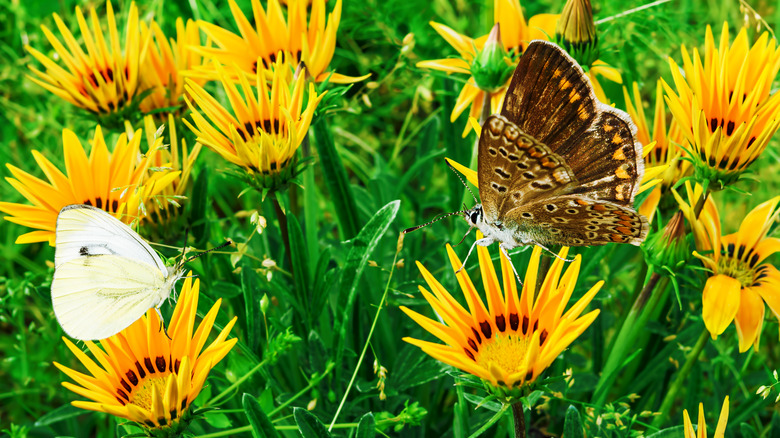Tricks To Keep Your Gazanias Full Of Stunning Blooms Almost All Year Long
Gazanias (Gazania rigens), also known as African daisies or treasure flowers, are stunning daisy-like flowers you'll want in your garden if you want to attract butterflies, bees, and other pollinators. Their showy blooms reach up to 4 inches in width and come in several warm shades, including orange, yellow, red, pink, and white. There are plenty of varieties to choose from, including bicolor with bold stripes or an eye-catching sunburst effect. Gazanias are relatively low maintenance, but if you want to enjoy all the beauty these flowers have to offer, there are a few tips and tricks to keep in mind. Providing the proper growth conditions, the right fertilizer blend, and pruning when necessary all contribute to their blooming success.
As versatile plants, gazanias work well as borders or groundcovers in informal gardens. They also look great in containers and are perfect multicolor flowers for hanging baskets. No matter where you plant them, make sure they're in a spot that receives plenty of sunlight, as they need full sun to produce the best blooms. If you're someone who travels or can sometimes be a bit forgetful when it comes to watering, gazanias will be your favorite plant. They're extremely drought tolerant once established and only need water during long, dry periods. They're hardy in zones 8 through 10 but can grow as annuals in cooler areas. It's important to note that gazanias are considered invasive in California and other areas, so check your local ordinances before planting.
Fertilize your gazanias the right way
Gazanias are flowering plants that thrive near the coast because of their sandy soil preferences. Although poor soil quality isn't an issue when growing these beautiful plants, it doesn't mean they don't benefit from some food every now and then. Although fertilization isn't a requirement for these easy-going flowers, applying a slow-release, well-balanced fertilizer as the growing season begins will help them bloom more profusely. However, don't make the mistake of eager gardeners who overdo it in an attempt to increase flower production. Too much fertilizer can have the opposite effect, causing the energy to go toward foliage growth instead.
To fertilize gazanias properly, follow the instructions provided to determine how to apply it. When fertilizing your plants, it's crucial to avoid applying it overhead as you don't want it to land on the petals. Instead, focus on distributing it evenly across the soil. Once you've given your plants their food, give them a light watering to help the fertilizer seep into the soil and help prevent root burn. You'll know pretty quickly if you've given your gazanias too much fertilizer for them to consume. If the leaves suddenly turn yellow, start browning on the edges, or fall off, it's a sign they've gotten more food than they can eat. You may also notice a crusty white dusting across the top of the soil. Remove what you can and use water to help flush away what's left.
Encourage new blooms by deadheading
While you may not need to worry much about watering or soil quality to ensure vibrant gazania blooms, deadheading will help the plants continually bloom. The best time to prune perennial gazanias is in early spring to get them ready for the growing season. Simply pinch back the plant to help encourage its health. Once it starts growing new stems and flowers, it'll look even better than before and reward you with bushier growth. Make sure to use sanitized gardening tools when pruning anything growing in your garden. Dirty shears can spread diseases or pests, which could damage or even kill your plants.
Aside from annual pruning, you'll want to keep up with deadheading spent flowers regularly. Keep an eye on your plants and remove any blooms that have died off to give them space to push out new growth. Luckily, this maintenance is pretty easy to keep up with and because the stems are thin, you can use your fingers to easily remove them. Aim for the area right below the spent flower and directly above the first set of healthy leaves. Now, your gazanias will be ready to produce more vibrant blooms that'll wow your guests, including thirsty pollinators who'll be excited to pay your garden a visit.


